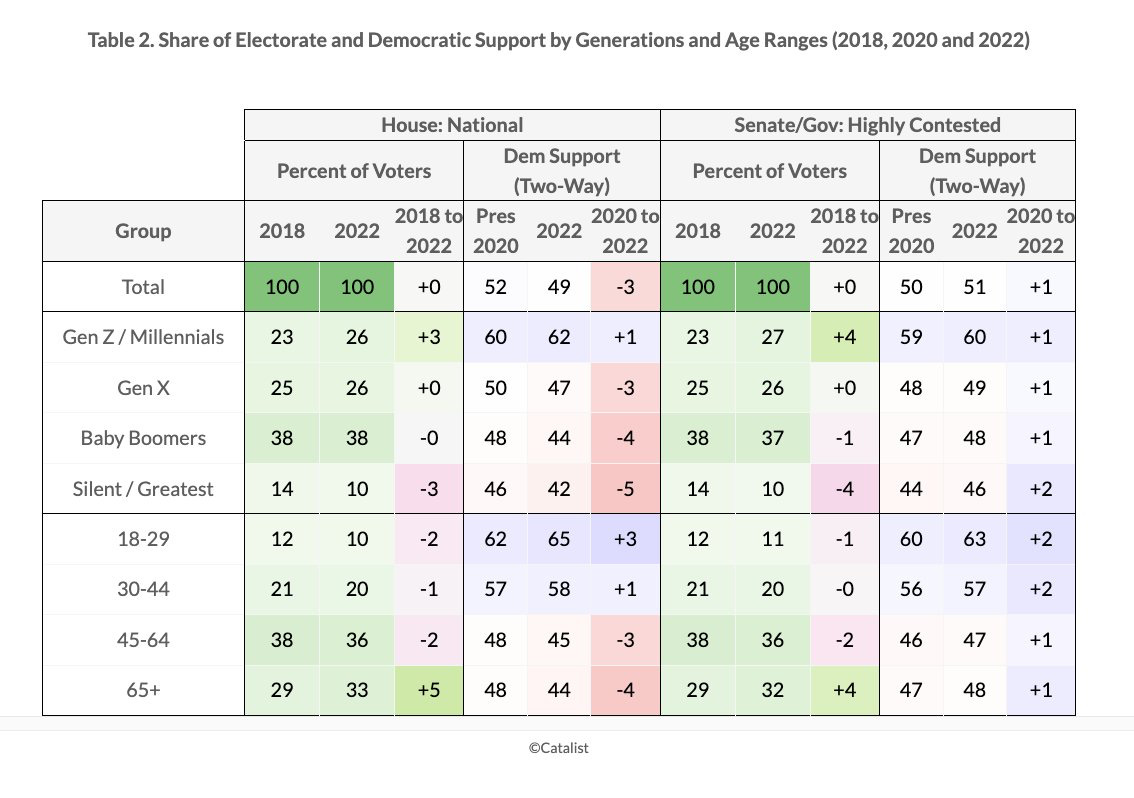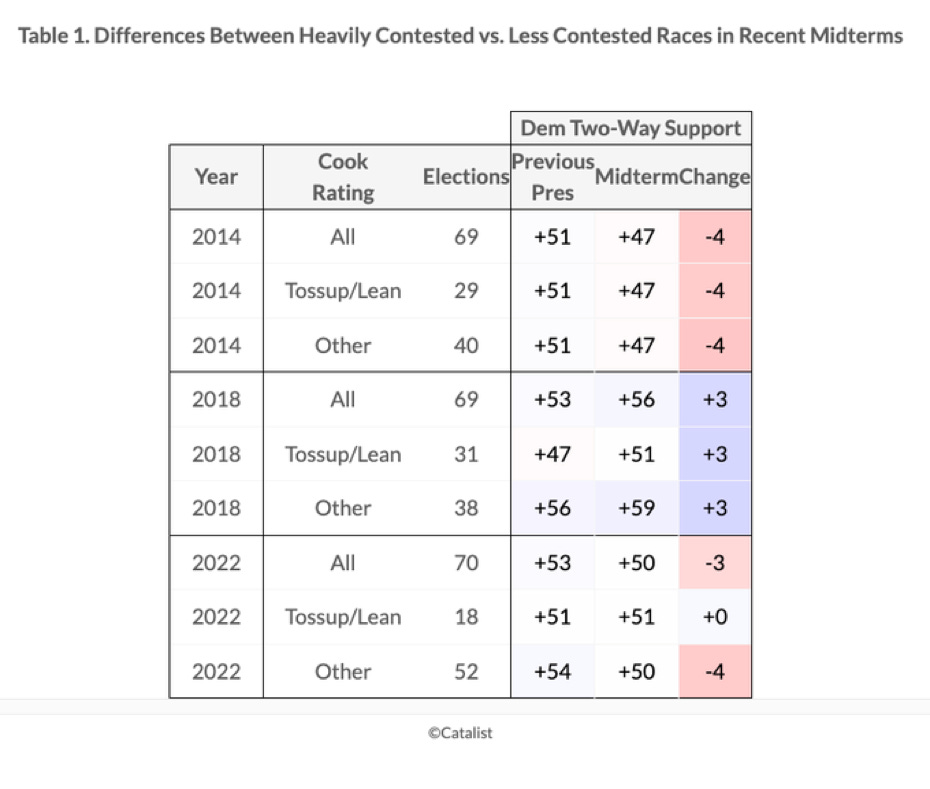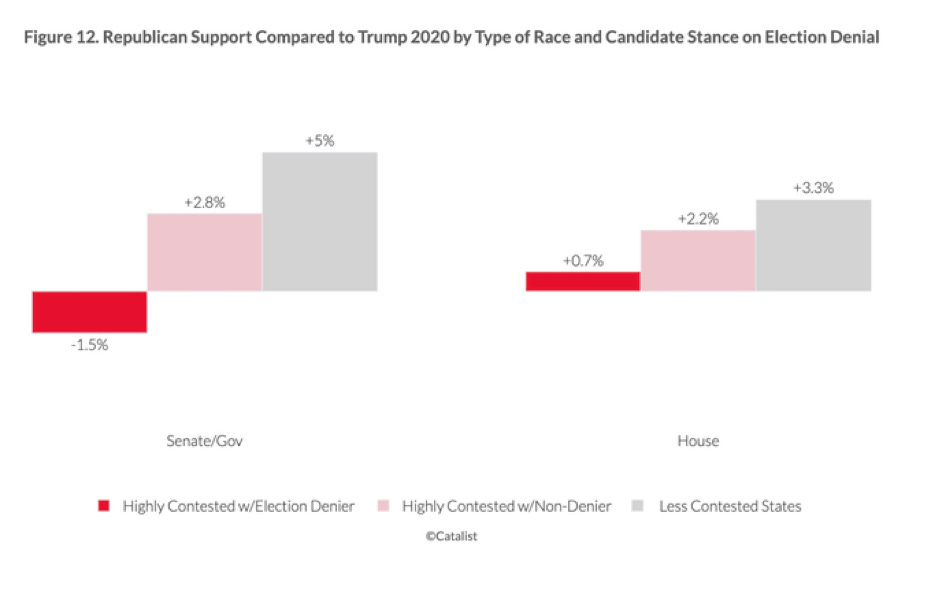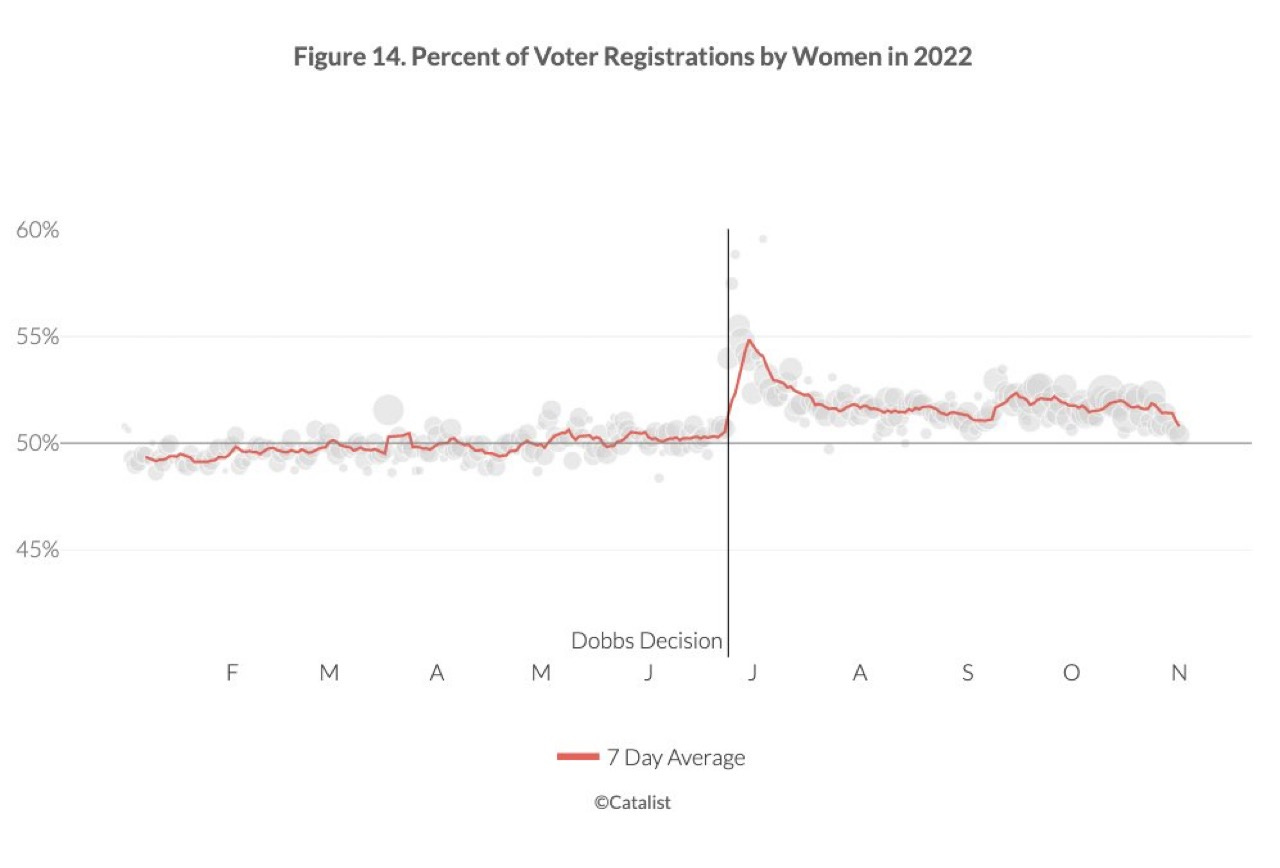The Deep Data Is In. And Democrats Should Cheer.
It’s a chart day! Data geeks, rejoice, for numbers have arrived.
I promise to make this discussion accessible and even a bit fun. But first, let me set the stage.
It’s been a bit over six months since the midterm elections of 2022, which the GOP by all accounts bungled badly by nominating so many Trump-endorsed, extremist candidates. By the end, the Democrats had increased their numbers in the Senate by one seat and barely lost the House, with a swing of just nine seats, far less than the crushing and historically predicted 30 plus. That left Kevin McCarthy fighting for his political life, cutting deals with the extremists in order to be elected Speaker.
There has been much high-level analysis of what led to the red wave crashing lamely against a sturdy blue wall. It was a result that lonely voices, including myself and election data expert Simon Rosenberg, had been predicting, despite the rash of bad poll numbers. (Those polls, by the way, wound up being wholly manufactured by right-leaning outfits.)
For my part, and based on data on new voter registrations and early voting, I had predicted that women and youth voters would turn out in historically high numbers, especially in battleground states. This would be due largely to the Dobbs decision eliminating the constitutional right to abortion. But I was concerned about low turnout in “safe” blue states where abortion was not on the ballot, and that this could cost us our House majority.
These things wound up being true, but I have been waiting for the numbers to confirm exactly why and by how much. In the days leading up to the election, Targetsmart, an election analytics firm, had reported early voting data generally supportive of these results. But now, a new post-election deep dive report on nationwide voting data by the firm Catalist, appropriately entitled the What Happened analysis, has finally confirmed important figures.
And it’s very good news for Democrats. Let’s take a look at the top line takeaways. Charts charts charts!
The youth vote was decisive
We need to stop wringing our hands about young people not being involved or turning out to vote. That stereotype needs to be put to rest for good. The current crop of young voters (Gen Z and Millennials) are, by historic comparison, highly engaged. And they delivered decisive numbers in key battleground states in 2022.
Charts can be confusing, so I’ll direct you on this one. Look just at the greenish columns for now. They compare turnout (as a percent of the electorate) in the 2018 and 2022 midterms, broken down between the House: National races (left side) and the Senate/Gov: Highly Contested races (right side). See the Gen Z/Millennials row near the top? That shows that from 2018 to 2022, these voters increased their share of the total vote by 3% for House races and 4% for the highly contested Senate/Gov races, while the oldest demographic decreased by the same amounts. That’s a gigantic shift.
Okay, now look at the purplish Dem Support columns. They represent what percent of these voters went for the Democratic candidate in a two-way race, again broken down by House: National or highly contested Senate/Gov races. Check out the Gen Z/Millennial row again. It went up from 2020 to 2022 by one percent—and that’s on top of an already whopping 59 to 60 percent baseline support for the Democrats. The takeaway? Youth support for Democrats actually increased through the Biden years.
One more thing to notice: We’re below 50 percent support for the Democrats in every other age group. It’s literally young people with their increased turnout who are keeping us from sliding into a GOP-led hellish nightmare.
Battlegrounds and toss-ups were won by Democrats
Okay, same chart above, which I’m copying again below so you don’t have to keep scrolling back and forth.
Taking just the far right column and comparing 2020 to 2022, in every age category the movement was toward the Democrats in the highly contested Senate/Gov races. That means Democrats did better in the 2022 midterm in these close races than they did in 2020.
Now look again at the bottom half of the chart. See all that purple in the 18-29 and 30-44 rows? This should make you cheer! Voters aged 18-44 skew highly toward the Democrats, and the numbers are going up over time, not down. And bonus: the right side shows that even the country’s older voters moved toward the Democrats in the states and races that were highly contested, in particular the battleground states of Pennsylvania, Michigan, Wisconsin, Arizona, Georgia and Nevada.
Why does this make me smile? Because those are the very same states that will decide the fate of the White House in 2024.
The House tells a similar story with respect to highly competitive races. Every election cycle, the Cook Political Report compiles a list of the House races that it considers “toss-ups.” Let’s look at how the Democratic candidates fared in those toss-ups. The key row is the second to the last one:
The party in power is expected to see a lot of red in the first midterm of a new president. But look: No red in that row!
That means in the House races considered too close to call, voters turned out in numbers similar to how they supported Joe Biden in 2020: at 51 percent. House Democrats were able to hold on to way more seats than anyone expected, because it was mostly their seats that were up for the flipping.
Election deniers sucked it
We knew anecdotally that Trump-endorsed candidates such as Keri Lake in Arizona, Doug Mastriano in Pennsylvania, and Hershel Walker in Georgia did quite poorly. All these candidates also denied the results of the 2020 election, falling in line with Trump. But did they actually do worse than other, run-of-the-mill GOP candidates?
Yup. This chart looks at the Senate/Gov races on the left and the House races on the right and compares the GOP support for the candidate in 2022 versus in 2020. The bright red means a highly contested race with an election denier. The pink is a highly contested race without an election denier. The gray is every other race in non-contested states. You can see that GOP support falls off when an extreme election denier is on the ballot. In the highly contested states, they lost a whopping four percentage points.
Now, a caveat: Election deniers often come with all kinds of other MAGA baggage that could sour them to their own GOP voters. But fealty to Trump generally means beating the drum of a stolen election, and that simply is turning off a slice of GOP voters. It’s a very important slice. In some cases, decisive.
This will have big implications if Trump continues to insist, as he did in his recent “town hall,” that the election was stolen and that candidates have to sing this tune again to win his support. (Spoiler alert: He will.)
Women voter registrations spiked after Dobbs and stayed high
Months before the election, I pointed out that data in the swing states where abortion was on the November ballot was showing a high number of new voter registrations among women compared to men. I argued that a high female voter turnout could spell disaster for the Republicans in those states.
The national numbers are now in, and just look at this chart:
The vertical line is the Dobbs decision. Women versus men voter registrations in 2022 spiked at that point and stayed high all the way through November.
That is a very clear indication that women voters were motivated and intended to turn out in high numbers. As red-state legislatures across the country continue to ban or severely restrict abortion access, we will likely see women voters increasingly angry and ready to unleash that anger at the polls.
A lasting impact
When we see women and youth voters registering and turning out in record numbers, that isn’t a flash in the pan. Voters who get engaged in politics tend to stay engaged. The GOP understands this, so it is desperate to keep young people, minorities and women from fully exercising the franchise.
As the demographics turn increasingly against the GOP, the right move for the Republicans would be to adjust their policies to win voters back. But they seem uniquely incapable of doing this. Instead, they are doubling down on the policies most disfavored by these voters, such as abortion bans, attacks on LGBTQs, climate denialism and firearm free-for-alls.
The next few election cycles will test the limits of our system, with all-out democracy repression by the GOP and an all-out push for even greater voter engagement by the Democrats. These numbers from Catalist tell us that by 2032, the GOP as a political force is in grave danger of collapse as its older supporters dwindle.
They also tell us that Gen Z and Millennials, as they become the dominant voting bloc in America, stand ready to usher in a new era of progressive politics. This is why I remain hopeful for our future. We can get there—if we work very hard now to keep our Republic so that we have something to hand over to the young generations in the coming decade.






This is great news but one thing be must be said repeatedly, never be complacent!
Believing your vote will not matter, is a recipe for disaster. Consider every vote as the difference between winning or losing!
So very proud of the Gen Z and Millennial generations...
Why wait until 2032? I bet we can make the Republican party collapse earlier if we really put in the effort!